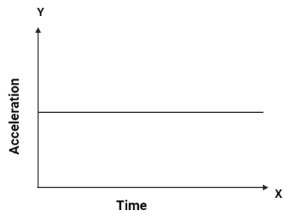
For a graph for acceleration against time for a uniformly accelerated motion. Which of the following is /are true?
A) Graph will be straight line parallel to the time axis
B) The slope of graph is zero
C) Both A & B
D) None of the above
Answer
510.3k+ views
Hint: Acceleration is the rate of change of velocity. The change of velocity occurs because of the change in the speed of the object or the change in the direction of a moving object.
Complete step by step answer:
If an object increases its speed at a constant rate , then the acceleration is said to be uniform . If it keeps increasing and decreasing the speed simultaneously then it’s not a uniform acceleration.
Hence for a uniform accelerating motion , the acceleration with the passage of time remains constant. The acceleration in this question is a constant value. Therefore, we see that the acceleration and time graph will remain parallel to the time axis.

Hence, Option (A) is correct.
Now, a line parallel to the x axis is known as a horizontal line. As shown in the graph , the acceleration time graph is independent of x. If the line moves upwards then the slope is a positive value, if it moves downwards then it is a negative value. But in this case the lines are parallel , Therefore, the slope will be zero.
Hence, Option (B) is also correct.
So, The final correct answer is Option (C) , that means both A and B are correct. The Graph will be straight parallel to the time axis and the slope of the graph is zero.
Note:
The acceleration of an object depends on two factors: the force applied on the object and the mass of the object. Based on these two factors we are able to predict the trend of the velocity, which further helps in predicting the slope of acceleration.
Complete step by step answer:
If an object increases its speed at a constant rate , then the acceleration is said to be uniform . If it keeps increasing and decreasing the speed simultaneously then it’s not a uniform acceleration.
Hence for a uniform accelerating motion , the acceleration with the passage of time remains constant. The acceleration in this question is a constant value. Therefore, we see that the acceleration and time graph will remain parallel to the time axis.

Hence, Option (A) is correct.
Now, a line parallel to the x axis is known as a horizontal line. As shown in the graph , the acceleration time graph is independent of x. If the line moves upwards then the slope is a positive value, if it moves downwards then it is a negative value. But in this case the lines are parallel , Therefore, the slope will be zero.
Hence, Option (B) is also correct.
So, The final correct answer is Option (C) , that means both A and B are correct. The Graph will be straight parallel to the time axis and the slope of the graph is zero.
Note:
The acceleration of an object depends on two factors: the force applied on the object and the mass of the object. Based on these two factors we are able to predict the trend of the velocity, which further helps in predicting the slope of acceleration.
Recently Updated Pages
Master Class 12 Business Studies: Engaging Questions & Answers for Success

Master Class 12 Economics: Engaging Questions & Answers for Success

Master Class 12 English: Engaging Questions & Answers for Success

Master Class 12 Maths: Engaging Questions & Answers for Success

Master Class 12 Social Science: Engaging Questions & Answers for Success

Master Class 12 Chemistry: Engaging Questions & Answers for Success

Trending doubts
What is meant by exothermic and endothermic reactions class 11 chemistry CBSE

Which animal has three hearts class 11 biology CBSE

10 examples of friction in our daily life

One Metric ton is equal to kg A 10000 B 1000 C 100 class 11 physics CBSE

1 Quintal is equal to a 110 kg b 10 kg c 100kg d 1000 class 11 physics CBSE

Difference Between Prokaryotic Cells and Eukaryotic Cells




